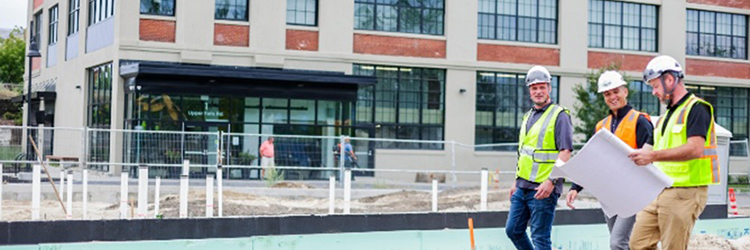Commercial deal flow trends indicate return to normal and growth potential - by Joe Atwood

As we move through Q3, local and national data on commercial real estate deal flow is painting a promising picture for year-end transaction volumes and stabilized sales trends. While the market has shown volatility in 2023 and early 2024, numbers are trending upward and there is a sense that we are entering a period of increased market stability and steady growth, akin to pre-pandemic trends.
According to CoStar Analytics, by June of this year property sales nationwide reached $211 billion across the key sectors — office, industrial, retail, multifamily, and hospitality. Although this represents a 4% decline from the previous year, there are promising indications that transaction activity may be heading towards a steady growth pattern.
The challenges of the post-pandemic world of 2023, magnified by surging interest rates and talk of a recession, caused many sellers, uncertain about the economic climate, to withhold their properties. This ultimately led to stagnant transaction volumes and missing the typical year end uptick in sales. Recent Q2 data suggests a strong finish to 2024, but also a return to more “normal” market trends compared to 2020-2023.
2024 Q1 transactions totaled $94 billion, reflecting a sharp 17% decrease compared to the same period in 2023. The second quarter, however, saw a resurgence with $117 billion in deals, a 9% increase from the previous year. This improvement aligns with a broader market expectation for an interest rate cut by the Federal Reserve in September, which could lower borrowing costs and potentially rejuvenate end of year sales volume.
Supporting this return to stability and normalized market trends, is a comparative analysis of current deal flow volume versus pre-pandemic five-year averages. Q1 of 2024 reached 75% of the five-year average, while Q2 saw an increase to 84%. All signs point to a continued upward trend and increased market stability.
Turning our attention to Maine’s primary markets, the state’s commercial real estate deal flow trends show steep declines in transaction volume compared to the banner years of 2021 and 2022, and a consistent downward trend in 2023 and year-to-date (YTD) in 2024. However, zooming out to five-year averages paints a steadier picture and a return to more normalized sales environment, with promising trends in the industrial sector.
Greater Portland YTD transaction volume is roughly $331 million, showing a 28% decrease in year-over-year (YOY) sales volume. This is fueled by a continued two-year downward trend in the office sector, and a dramatic 46% decrease in YOY retail transactions. While retail and office struggle to recover, industrial is showing promising signs of market improvement with nearly a 23% increase in transactions YTD in 2024.
In a small market like Portland, just a few large transactions can dramatically impact sales data. So, while these fluctuations seem extreme, zooming out to five-year averages offers a less dramatic view of the market. Provided we receive the typical year end increase in transactions, 2024 deal flow volume is poised to well exceed the five-year average of $377 million.
The market in Bangor and other primary markets in Maine, paint a very similar picture to Portland, suggesting market stability and upward momentum statewide compared to five-year averages. Bangor saw similar, extreme drops in retail and office, but a roughly 32% YOY increase in industrial transactions. If Bangor follows a similar trend to Portland, it is also poised to well exceed the five-year average across all sectors of roughly $32 million in 2024.
When comparing the current market in Maine to the astronomically high sales volume of 2021 and 2022, it’s easy to feel like we are in a steep downward trend. Yet comparing YTD trends to five-year averages, support the perception that we are returning to a sense of normalcy. There is even cause for cautious optimism, with the potential for reduced borrowing costs stimulating local investment activity and enhanced deal flow in the state.
While potential rate cuts supporting a strong end to 2024 is cause for optimism, what is more promising to see, is five-year averages suggesting more long-term market stability and the potential for steady and sustained growth.
Joe Atwood is a sales agent with The Dunham Group, Portland, ME.
Reveler Development celebrates final phase of work at The Levee - new 51-unit apartment building in Biddeford


Interest rates and inflation - by Matthew Bacon
As we all know, interest rates have been changing drastically, with movement in both directions, depending on the type and term of financing. The Federal Open Market Committee has taken drastic action in efforts to curb abnormally high inflation, but it hasn’t controlled labor cost growth to the extent that was intended.

Residential is here to untie the office space doom loop - by Thomas House

The Greater Portland industrial mid-year market update - by Nate Roop

Maine multifamily outlook: Opportunities in Portland, Bangor, and Lewiston-Auburn - Blake Wright and Kristie Russell
The multifamily market in Maine’s major cities presents a diverse range of opportunities for investors. We looked at the potential benefits and unique characteristics of three major submarkets in the state: Portland, Bangor, and Lewiston-Auburn. The information below is based on research done in CoStar and county registries, and focuses on multifamily properties that have four or more units.

 (1) (1).png)





.png)


.png)